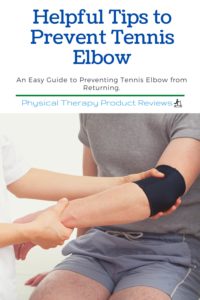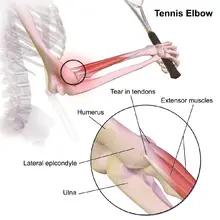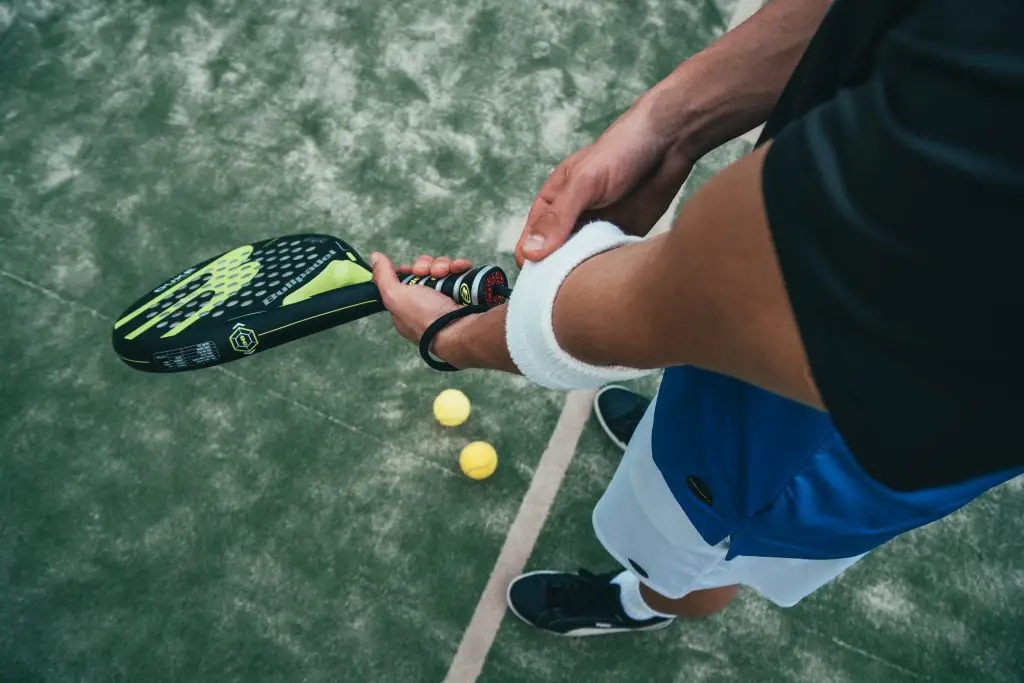As an indispensable part of our bodies, the elbow is extremely unappreciated. Unless we have banged it up against a wall, setting off that sharp, tingling sensation, we often forget it is there. When we stop and think about it, our elbow joint is necessary to complete the most menial of tasks. While the effects of ‘tennis elbow’ are not life-threatening, they can impede on everyday life, from picking up our children to gripping a cup of coffee.
What is Tennis Elbow?
Medically known as lateral epicondylitis, ‘tennis elbow’ is the occurrence of pain due to the overuse of the elbow tendons, usually repetitive motions. Although named after the sport, it is just as frequently caused by work related activities that require a fine, repeated wrist motion, and weight lifting. People affected can include bricklayers, painters, musicians, and some racquet sport athletes, typically between the ages of 30 and 50. However, it can develop in young, rigorous athletes.
 Signs of ‘tennis elbow’ include pain, often a burning sensation, radiating from the outside of the elbow. It typically affects the dominant hand, and results in a weakened grip. Symptoms gradually develop, meaning that with the right treatment, deterioration can be prevented. The condition is rarely serious and can be resolved with physical therapy, changes in activity, or a brace. ‘Tennis elbow’ is specific to the tendons that attach to the bone on the outside of the elbow. As the condition involves a tendon, it is classified as a form of tendinopathy. It is important to note that this is different from tendinitis. Whereas tendinitis is specific to tendon inflammation, tendinopathy is a broad term for pain due to overuse. A similarly general condition, is the equally common ‘hiker’s knee’.
Signs of ‘tennis elbow’ include pain, often a burning sensation, radiating from the outside of the elbow. It typically affects the dominant hand, and results in a weakened grip. Symptoms gradually develop, meaning that with the right treatment, deterioration can be prevented. The condition is rarely serious and can be resolved with physical therapy, changes in activity, or a brace. ‘Tennis elbow’ is specific to the tendons that attach to the bone on the outside of the elbow. As the condition involves a tendon, it is classified as a form of tendinopathy. It is important to note that this is different from tendinitis. Whereas tendinitis is specific to tendon inflammation, tendinopathy is a broad term for pain due to overuse. A similarly general condition, is the equally common ‘hiker’s knee’.
Understanding the Anatomy of the Elbow
As with most conditions, understanding our treatment options begins with knowledge. The anatomy of the elbow joint happens to be one of the most complex joints in the body.

The lateral epicondyle is a small nodule that sits on the outer side of the humerus, our upper arm bone. From this point, tendons attach to a variety of forearm muscles. As the weight exerted from our wrist becomes too much, our tendons transfer it to the ulna and radius bones. With overuse, the tendons develop micro-tears, risking the crucial weight transfer and leaving it to fall on our forearm muscles. Most commonly affected, are the Extensor Carpi Radialis Brevis (ECRB), and the Extensor Carpi Radialis Longus (ECRL). As ‘tennis elbow’ worsens, the function of these two muscles can be compromised, resulting in a weakened wrist and grip strength.
Five Tips Avoiding Tennis Elbow
There are several ways to effectively prevent ‘tennis elbow’, before it is present. If symptoms are already present, these methods are still known to reduce pain and assist with rehabilitation. In the event that pain persists or worsens, seek out a physician for individualized treatment.
Strengthen the Forearm Wrist Extensors
One of most effective treatment options is to strengthen the forearm muscles, thereby decreasing the chance of muscle tears. In a 2008 study, a muscle-strengthening program was determined to be an “inexpensive” and “convenient” treatment for ‘tennis elbow’.
Learn Proper Form and Wrist Position
When executing any motion it is important that we use proper form. Prevent exacerbating ‘tennis elbow’ by using a neutral wrist during work and sports. Employing a physical therapist can help target and strengthen specific muscles – lessening the occurrence of flare ups.
Avoid Aggravating Forearm Positions
Sometimes playing it safe is the best way to go. It is important that we are capable of using the full range of motion of our elbow joint, but it is unnecessary to use the entirety of that motion with every movement. Staying within the middle of our range is an effective way to rest the joint and allow it to heal.

 Use A Forearm Brace
Use A Forearm Brace
To help alleviate strain on the joint, and reduce pain, wearing a ‘tennis elbow’ brace may be helpful. Resume everyday work or play, and view our comprehensive list of the top-rated braces on Amazon.
Forearm Muscle Stretches
The forearm muscles attach at the elbow and take a lot of heat. By stretching these muscles, we can prepare for the oncoming weight and increase our resistance to injury. Two beneficial ‘tennis elbow’ exercises include fist clenches and towel twists.
FAQ for Tennis Elbow
What Causes Tennis Elbow?
Tennis elbow, also known as Lateral Epicondylitis, is caused by overuse of the wrist extensor muscles located in the forearm. Once those muscles have been overused with repetitive motion, it can cause pain and micro tearing in the tendons.
How Long Does Tennis Elbow Last?
Tennis elbow can last as little as a few weeks and can last as long at a couple year if it is left untreated. The sooner that it is treated and activities modified, the sooner that the pain will go away.
Do I Need to Have Surgery for Tennis Elbow?
Not typically. Surgery for Tennis elbow is extremely rare with most cases resolving with conservative management that involves physical therapy, bracing, and even steroid injections.
What is the Best Treatment for Tennis Elbow?
The best and first option should be physical therapy. This is the best option to resolve symptoms and strengthen the area to prevent it from coming back. Physical Therapy is also the least expensive in most cases when compared to injections and medications which only mask the symptoms and don’t stop it from coming back.
Other Great Rehab Related Articles
How to Stay Active After Cervical Fractures: Expert Tips and Advice
Dealing with Painful Stairs After Ankle Replacement Surgery
Walking After a Total Ankle Replacement: Tips for a Successful Recovery
Exercises While Non-Weight Bearing After Ankle Replacement: Elevation, AROM, Leg Raises, and More
Ankle Pain with Stairs: Causes and Home Treatment Options
5 Common Mistakes You’re Making After an Ankle Sprain
Disclaimer: The information provided in this post is for educational purposes only. This is not a substitute for a medical appointment. Please refer to your physician before starting any exercise program.








